The Faraday Institution SEED Project (June 2022 – June 2023)

Ana has been awarded a SEED project funded by The Faraday Institution to explore the manufacturing of 3D porous carbon electrodes via 3D printing and electrospinning for application in redox flow batteries. The project will fund a PDRA for one year to conduct experiments at the QMUL School of Engineering and Materials Science.
The Royal Society International Exchanges QMUL – MIT (March 2022 – March 2024)
 Ana has been awarded a Royal Society International Exchanges Grant with MIT. This grant (March 2022 – March 2024) will start a new collaboration with Prof Brushett from MIT (Massachusetts Institute of Technology, Chemical Engineering Department) and his team. During this collaborative project Prof Brushett and several members of his team will visit our facilities and work in our labs to develop new understanding on electrode materials for redox flow batteries. Likewise, Ana Sobrido and several members of her research group will visit Brushett group’s facilities and acquire new knowledge in stack testing and techno-economic analysis of the introduction of biomass-waste electrodes and replacement of commercial carbons.
Ana has been awarded a Royal Society International Exchanges Grant with MIT. This grant (March 2022 – March 2024) will start a new collaboration with Prof Brushett from MIT (Massachusetts Institute of Technology, Chemical Engineering Department) and his team. During this collaborative project Prof Brushett and several members of his team will visit our facilities and work in our labs to develop new understanding on electrode materials for redox flow batteries. Likewise, Ana Sobrido and several members of her research group will visit Brushett group’s facilities and acquire new knowledge in stack testing and techno-economic analysis of the introduction of biomass-waste electrodes and replacement of commercial carbons.
The award will be the foundation for further collaborative research.
UKRI Future Leaders Fellowship – Sustainable Electrodes for Advanced Redox Flow Batteries (February 2021- February 2025).

Ana has been awarded an UKRI FLF (£1.4M) to design new alternative electrodes for redox flow batteries obtained from biomass and biomass waste, using electrospinning to process it into freestanding fibre mats. Wind power and solar energy are promising alternatives to fossil fuels and support worldwide efforts to decarbonise energy generation. However, unlike fossil fuel-based methods of energy generation, renewably sourced energy is generated discontinuously. For example, wind turbines are only able to produce energy in the right weather conditions. As a result, this type of energy production creates a big demand for energy storage, and is not supported by current electricity grids. Redox flow batteries (RFBs) are well suited for large-scale energy storage, combining desired features such as long cycle life, high reliability, and low maintenance. Whilst they present a commercially attractive and flexible platform for the UK’s future energy storage, the current polyacrylonitrile-based carbon electrodes used in these systems are less than ideal, and result in low efficiency systems.
Supported by the Future Leaders Fellowship, Ana aims to develop sustainable electrodes for advanced flow batteries, including solar flow batteries and metal-air flow batteries. These innovative technologies could be key to the search for alternative energy conversion and storage systems with high energy densities and improved efficiency. Being able to combine the use of solar energy and flow battery technology could open new avenues to storing energy at large scale.
3D- Printed Electrodes for Energy Conversion and Storage Technologies (March 2020 – March 2021)

Sustainable energy production at an acceptable cost is key for its widespread application. At present, noble metals and metal oxides are the most widely used for electrocatalysis, but they suffer from low selectivity, poor durability and scarcity. The search for new materials and structures that use non noble metals is of paramount importance. 3D printing has received increasing attention in recent years, due to its flexibility and ability to design electrodes, which can incorporate electrocatalytic functional materials. This method enabled excellent control and tuneability of geometries and sizes at the micrometre scales while maintaining the characteristic advantages of their components. Another advantage of 3D printing technologies has to do with the ability to produce single parts consisting of multiple materials, even with printed gradients, which leads to highly tailored materials. However, the application of 3D printed electrodes in electrocatalysis is relatively new, only gaining momentum in the last years. Here I propose to use 3D printing to explore new electrode composites consisting of nanostructured graphene / transition metal electrocatalytic species for application in energy storage and conversion technologies. This research will lead to the development of a variety of electroactive composites, with different geometries and microstructures, and high electrocatalytic performance for batteries, fuel cells and water electrolyser systems. This research has the potential to truly transform the field of electrode design and expand the use of 3D printing techniques for the processing of new electrocatalytic architectures.

Bacterial Nanocellulose for Energy Conversion and Storage Applications (April 2020 – October 2021) – funded by British Council and Newton Institutional Links
Ana Belen Jorge, Petra Szilagyi, Cristina Isabel Castro, Esteban Garcia Tamayo (Universidad Pontificia Bolivariana) –
Colombia is one of the world’s megadiverse countries, hosting close to

10% of the planet’s biodiversity. Therefore, bioeconomy is a field with a large potential for economic activities, mainly driven from new discoveries in the biological sciences. The last National Development Plan (PND, 2017) identified an economic growth strategy where biological resources and residual biomass must be managed in an efficient and renewable way to generate new products, processes andservices with added value, as new levers for development. Our project aims to reuse the leftover of the fique natural fiber production (juice) from local producers (AGAVE S.A.S) in Antioquia, where close to 100 farmers of fique fibers sell this raw material
at a price of $150 COP/kg for the production of sacks and cord. It is worth mentioning that only 4% of the fique plant is used for the extraction of fibers, leaving the remaining as waste. We will use the fique juice as a culture medium for the Komagataeibacter Medellinensis bacteria for the
synthesis of bacterial nanocellulose, which will be further activated for energy storage applications, including lithium-ion batteries and supercapacitors. With this project, we will support local farmers, who will benefit from selling their agricultural waste to biomass companies, providing farmers a new source of income. The proposed collaboration involves Universidad Pontificia Bolivariana (UPB) and Queen Mary University of London (QMUL). Two research groups at UPB will join efforts for this project: new materials (GINUMA), energy and thermodynamics (GET). From QMUL, Dr. Jorge and Dr. Szilagyi will bring their experience in the application of biomass-derived materials as alternative energy compounds for storage and conversion. The knowledge of the UPB-QMUL team guarantees the project will be a success. We hope this institutional link fund will help us launch this collaboration further, including the development of an exchange program between institutions.
Sustainable Free-Standing Electrodes for Advanced Flow Batteries (May 2017-2018) 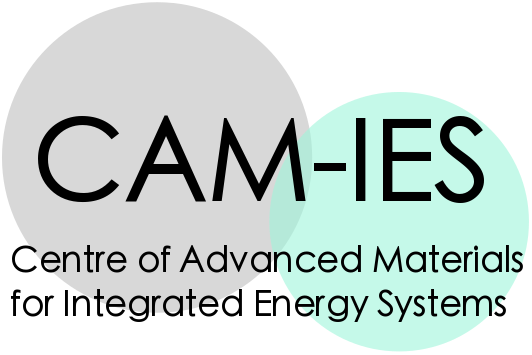
Rhodri Jervis, Maria Crespo Ribadeneyra, Ana Belen Jorge
Redox flow batteries represent a remarkable low cost and durable alternative for grid-scale energy storage. They often employ carbon felts or papers as the electrodes, but the activity towards the redox reactions are often poor, leading to low operating power densities. Additionally, the complex flow characteristics of the electrodes are often not well understood. This project will synthesise novel electrode structures from sustainable carbon sources via electrospinning, which will allow control of physical characteristics such as porosity, surface area and fibre size, but also to incorporate chemical species that help enhance the kinetics of the redox processes. Advanced x-ray imaging will provide a unique insight into the microstructural properties of the electrodes, and electrochemical testing in a full flow battery system will help identify new materials that will lead to improved flow battery performance and durability. The project will take advantage of already existing expertise and equipment at UCL and QMUL and will look to provide a proof of concept as a springboard for further funding and research. The rapid feedback of characterisation into the synthesis of the electrodes will allow expedited identification of desirable chemical and structural properties for the next generation of flow batteries.
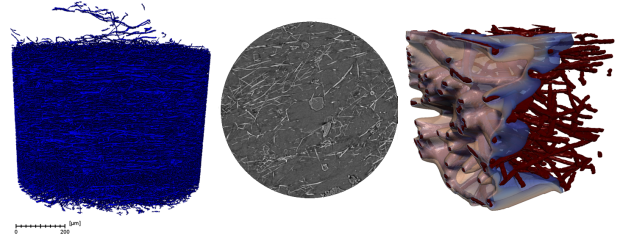
Figure 1. XCT electrospun fibres showing the 3D reconstruction (left), virtual slice (middle) and concentration profile modelling using the extracted structure.
Szymon Doszczeczko, Magda Titirici, A. Belen Jorge

The search for green alternative sources of energy is of great importance. To battle increasing global warming created by the use of fossil fuels, and to meet the UK’s 2050 climate change targets, new alternative technologies must be developed. Some of these include fuel cells, solar cells, batteries, supercapacitors and water electrolysers. Not only technologies, but research in new materials is equally crucial. Our group focuses in developing new nanostructures, composite and hybrid materials that can replace currently employed noble metals. Oxygen evolution reaction (OER) and oxygen reduction reaction (ORR) are key processes taking place in most of these devices, and are also focus of our studies. Not much research has been done to understand the effect of nanostructuring, hybridisation between various electrochemically active materials and understanding the structure-property relationships to allow an improved performance. Design and synthesis of new transition metal oxide perovskites/ N-doped C for OER and ORR catalysis using electrospinning.
Use of quantum dots to improve the performance of photo-anodes in solar conversion devices
Qian Guo, Magda Titirici, A. Belen Jorge
Synthesis and use of QDs to improve the performance of photoanodes in solar conversion devices, i.e. photo-fuel cells, photoelectrochemical cells.
Dina Ibrahim Abou El Amaiem, Paul Shearing, Dan J L Brett, A. Belen Jorge, Magda Titirici
With rapid development of the global economy, increasing environmental pollution and depletion of fossil fuels, there is a vital need for sustainable sources of energy as well as technologies allied with energy conversion and storage. Among many application fields, some of the most practical technologies for electrochemical energy conversion and storage are fuel cells, batteries and supercapacitors. Recently, these devices have attracted significant attention, each with recognized advantages. Driven by this need and the promise of the technology, significant progress of these devices has taken place.
One of the challenges of developing these technologies is the use of low cost and readily available materials that possess complex requirements of different applications. To overcome obstacles of high costs of raw materials and avoid usage of depleting sources, biocarbon materials are believed to lead the next generation of many industries due to their abundance, electrical conductivity, low cost and high specific surface area. Cellulose has eco-friendly attributes that are feasible to replace man-made fibers. Cellulose-based nanocomposites are being reinforced recently to make environmental-friendly products including lithium-ion batteries, electrode materials for supercapacitors and catalyst support in different electrochemical devices. Carbonization of cellulose yields carbons, including activated carbon and graphite fibers. The process briefly comprises of introducing the fibers in an inert atmosphere, preheating the fibers, treating them up to a certain temperature at which they carbonize and finally cooling the residues.
Microbial fuel cells for energy generation. Anaerobes are a unique class of organisms, they were able to survive the heavy bombardment of the Archean period by reducing various inorganic compounds to support their metabolism and drive respiration in the early Earth’s oxygen poor environment. Of all the bacteria that evolved during this period, some of the most interesting ones were the exoelectrogens, which were able to transfer electrons using extracellular routes to a 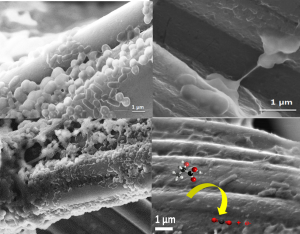 chemical that is not necessarily the immediate electron acceptor. This property allows them to function in microbial fuel cells, a sustainable technology that is being developed for simultaneous wastewater treatment and electrical power generation. There are still many limitations to overcome before microbial fuel cells can be implemented in real applications and fundamental knowledge of the biological processes behind the extra-cellular electron transfer mechanisms are still lacking. In this work, we will be presenting current research pertaining to Shewanella oneidensis MR-1. We also introduce the use of extreme conditions as a tool to investigate the mechanisms of biofilm formation and bacterial redox behavior of high pressure-adapted Shewanella oneidensis.
chemical that is not necessarily the immediate electron acceptor. This property allows them to function in microbial fuel cells, a sustainable technology that is being developed for simultaneous wastewater treatment and electrical power generation. There are still many limitations to overcome before microbial fuel cells can be implemented in real applications and fundamental knowledge of the biological processes behind the extra-cellular electron transfer mechanisms are still lacking. In this work, we will be presenting current research pertaining to Shewanella oneidensis MR-1. We also introduce the use of extreme conditions as a tool to investigate the mechanisms of biofilm formation and bacterial redox behavior of high pressure-adapted Shewanella oneidensis.
Green Carbon – Advanced Carbon Materials from Biowaste: Sustainable Pathways to Drive Innovative Green Technologies. H2020-MSCA-ITN-2016. The energy crisis, environmental pollution and global warming are serious problems that are of great concern throughout the world. Around 40% of the world’s energy consumption is dedicated to the production of materials and chemicals. Thus, there is a need to develop high-performance materials based on renewable resources, simpler to synthesise and cost effective. Carbon materials derived from renewable resources (e.g., biomass) are ideal candidates to meet these needs. The main objective of our proposed Innovative Training Network is to develop new scientific knowledge, capability, technology, and commercial products for biomass-derived carbons (BCs); thus impacting the way that Europe uses and innovates with sustainable carbon materials. This will be accomplished through outstanding research and training programmes
from renewable resources (e.g., biomass) are ideal candidates to meet these needs. The main objective of our proposed Innovative Training Network is to develop new scientific knowledge, capability, technology, and commercial products for biomass-derived carbons (BCs); thus impacting the way that Europe uses and innovates with sustainable carbon materials. This will be accomplished through outstanding research and training programmes 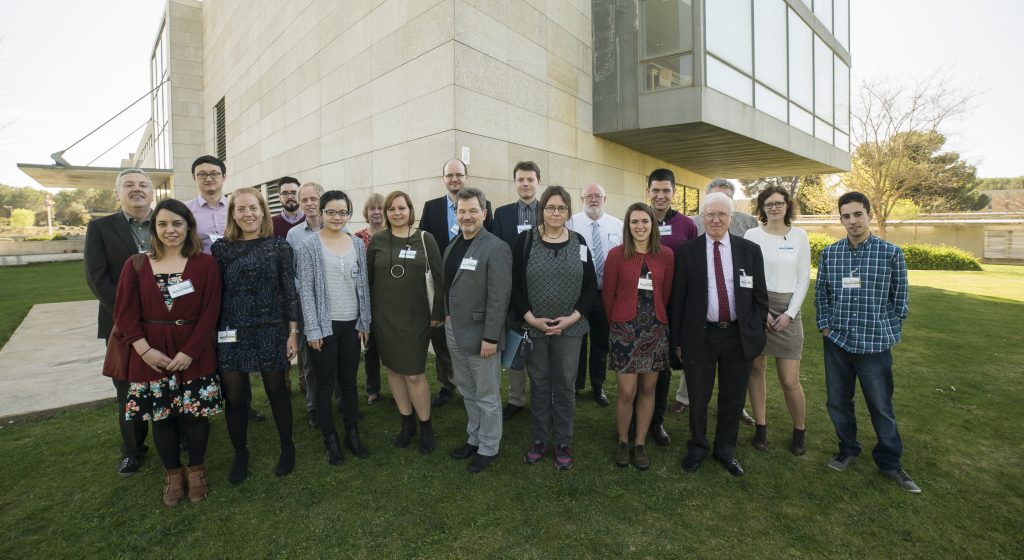 for fourteen early-stage researchers (ESRs). Our proposed research programme is feasible given the varied expertise and knowledge of the academic and industrial participants. We expect that GreenCarbon will improve our ability to rationally design a range of functionalised BC-derived materials using different individual and synergistically coupled processes and expand their practical applications. Our research programme comprehensively covers all aspects from precursors (the nature of biomass) to processing (thermochemical conversion, porosity development, chemical functionalisation) and application (e.g., CO2 capture, heterogeneous catalysis and chemicals from biomass) enabling a unique design of engineered sustainable BC materials. At the same time, our training programme is designed with the aim to empower the ESRs through the provision of a comprehensive and coherent training package, which includes complementary competencies and knowledge in all the science, engineering and business skills so as to be capable of deploying new technologies within different environments both inside and outside of academia.
for fourteen early-stage researchers (ESRs). Our proposed research programme is feasible given the varied expertise and knowledge of the academic and industrial participants. We expect that GreenCarbon will improve our ability to rationally design a range of functionalised BC-derived materials using different individual and synergistically coupled processes and expand their practical applications. Our research programme comprehensively covers all aspects from precursors (the nature of biomass) to processing (thermochemical conversion, porosity development, chemical functionalisation) and application (e.g., CO2 capture, heterogeneous catalysis and chemicals from biomass) enabling a unique design of engineered sustainable BC materials. At the same time, our training programme is designed with the aim to empower the ESRs through the provision of a comprehensive and coherent training package, which includes complementary competencies and knowledge in all the science, engineering and business skills so as to be capable of deploying new technologies within different environments both inside and outside of academia.


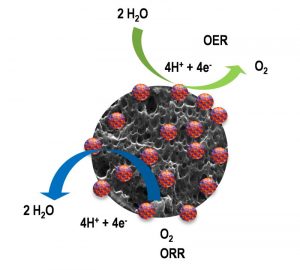 or OER and ORR prepared by electrospinning (December 2017 – December 2019)
or OER and ORR prepared by electrospinning (December 2017 – December 2019)